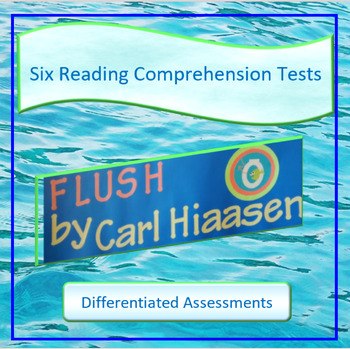Flush Reading Comprehension Tests ~ Whole Book ~ Differentiated Assessments
- Word Document File
- Easel Activity
- Easel Assessment
What educators are saying
Description
Dear Teachers,
This is a complete set; all six tests cover the whole book. These six ELA reading comprehension tests were written for Flush by Carl Hiaasen. This is a differentiated product written for traditional and inclusion classrooms.
This Package Includes:
- Six tests with page and paragraph numbers for each question
- Character study guides
- Modified sections for sequencing, quote and character identification
- Detailed answer keys
- Teacher's literary allusion notes
- 132 Pages
- 6 Easel Assessments
- 36 Easel Activities
Tests:
- Chapters 1 – 4 has 49 questions
- Chapters 5 – 8 has 37 questions
- Chapters 9 – 12 has 44 questions
- Chapters 13 – 15 has 46 questions
- Chapters 16 – 18 has 48 questions
- Chapters 19 – 21 has 40 questions
Type of Questions:
- Multiple choice
- Sequencing questions
- True/false
- Character identification — matching
- Identifying quotes — fill in the blank
These tests are easy to correct and provide an accurate tool to check student’s understanding of the material.
In keeping with the Common Core Standards, page numbers from the book are provided for each question for teachers who wish to encourage students to use the text to find their answers.
The word modified only appears on the teacher’s answer keys.
Answer Keys:
- Page and paragraph numbers for most answers
- Extra answer keys with sentences in chronological order for easy review of Easel moveable sentences
Easel Assessments:
- Chapters 1 – 4 has 42 questions
- Chapters 5 – 8 has 29 questions
- Chapters 9 – 12 has 36 questions
- Chapters 13 – 15 has 38 questions
- Chapters 16 – 18 has 41 questions
- Chapters 19 – 21 has 32 questions
- Multiple choice
- True/false
Easel Activities for Sequencing:
- 6 Self-checking drag and drop work sheets
- 6 Modified self-checking drag and drop work sheets
- 6 Work sheets with moveable sentences
- 6 Modified work sheets with moveable sentences
- 6 Work sheets with answer boxes
- 6 Modified work sheets with answer boxes
- Ready to assign; just one click!
- Self-checking, moveable sentences, or work sheets with answer boxes - with this product the choice is yours.
I’m sure you will be happy to use this material in your classroom. If you have any requests about my work, please drop me a note.






